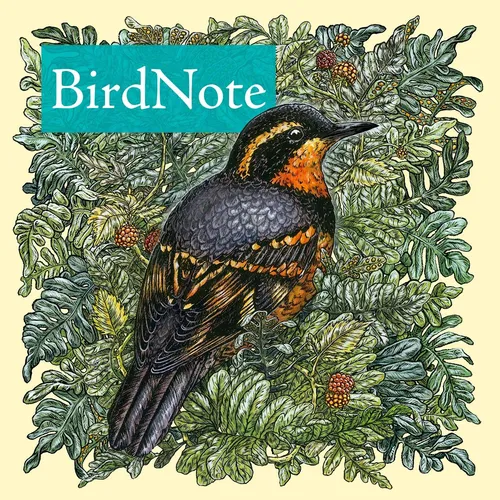
BirdNote Daily
Escape the daily grind and immerse yourself in the natural world. Rich in imagery, sound, and information, BirdNote inspires you to notice the world around you.
- Update frequency
- every day
- Average duration
- 1 minutes
- Episodes
- 1172
- Years Active
- 2022 - 2025

Listeners Help Us Delve Deeper
As part of our fundraising week, we’re sharing a clip from our podcast, Bring Birds Back. Because of listener support, we’re able to take our time and make long-form episodes that dig a little deeper…

Purple Martins Head South to the Amazon
The Purple Martin is the largest swallow that nests in the US and Canada. During fall, Purple Martins from western North America migrate to a distinct wintering area in southeastern Brazil — a travel…

Crowned-Pigeons: Big, Beautiful, Threatened
Imagine a pigeon the size of a Turkey Vulture or a Canada Goose! Meet the crowned-pigeon. Four species inhabit the large, equatorial island of New Guinea and a few smaller islands. Crowned-pigeons ar…

Putting the Hum in Hummingbird
To figure out the source of a hummingbird’s hum, scientists built a special rig to measure air pressure, twelve high-speed cameras, and over 2,000 microphones to observe hummingbirds fluttering in pl…

Migrations: Can Birds 'See' Magnetic Fields?
Some migratory songbirds such as European Robins have special light-sensitive proteins called cryptochromes in their eyes. New research suggests how the cryptochromes could alter their behavior in th…

Bilingual Birding with Daniela Herrera
For many, birding is about more than just a love and appreciation for birds – it also helps build community. But finding a birding group in a community where the primary language is not your own can …

The Bird of Freedom
There’s a bird in Cuba with plumage in blue, red and white — the same colors as the nation’s flag. The Tocororo, or Cuban Trogon, is the national bird of Cuba. When the Tocororo is kept in a cage, th…

Glowing Feathers
When a Northern Saw-whet Owl spreads its wings, many birds can see something our human eyes can’t: the owl’s flight feathers glow with ultraviolet light. It’s invisible to humans without the help of …

Great Horned Owl Family in Autumn
Compared to many birds, Great Horned Owls remain with their parents a long time. They hatched in early March, from eggs laid in late January. By April, both parents were hunting through the night to …

Detroit River International Wildlife Refuge
The United States is home to more than 550 National Wildlife Refuges – havens for wildlife, including the Canvasback. But only one refuge can claim the distinction of being international: the Detroit…

Bird Facts Stranger Than Fiction
Novelist Kira Jane Buxton has written several books about a pet crow navigating a post-apocalyptic world. But her writing is full of real-world bird behaviors. She has taken inspiration from how spar…

Fairy-Wrens Sing Secret Passwords to Unborn Chicks
Superb Fairy-wrens teach their embryonic chicks a secret code. This incubation call contains a special note that will later serve as a password. When the chicks have hatched, this password enables th…

The Eurasian Tree Sparrow
In Lafayette Park in St. Louis, Missouri, a dozen or so Eurasian Tree Sparrows from Germany were released. But unlike other introduced species such as the similar-looking House Sparrow, they did not …

BirdNoir: The One That Got Away
In this episode, the Private Eye tells his saddest story: his nemesis bird. That’s what birders call a species that keeps giving you the slip. His nemesis is the Painted Bunting, a colorful gem of a …

Birding 101: Birding Without Leaving Home
You don’t need fancy binoculars or lavish trips abroad to look for birds. In fact, you don’t even have to leave home — you can enjoy the birds out the window every day. And you don’t actually have to…

Montezuma Oropendola - The Golden Pendulum
In a clearing where an ancient Mayan city once stood, the Montezuma Oropendola perches and sings. His courtship display is astonishing: he swings by his feet and sings, his tail describing a golden p…

Prions Filter-Feed Like Whales
Birds called prions have an especially creative approach to getting their food. They pass seawater through their mouths and filter it to catch tiny animals such as krill and other small crustaceans. …

Yellow-Billed Cuckoo or Rain Crow?
In addition to their scientific names, birds are also given "official" English names. Take the bird commonly known as the rain crow, for example, officially referred to as the Yellow-billed Cuckoo by…

Sofia Barboza on Becoming More Aware of Birds
When climate scientist Sofia Barboza was living in New York City, she found it challenging to connect with the outdoors the same way she had growing up in Pennsylvania. Returning to live in Pennsylva…

Migrations: You're Going the Wrong Way!
During migration, some birds change orientation, often by a full 180 degrees, and travel almost the same distance — but in the opposite direction — as the rest of their species. The phenomenon is cal…